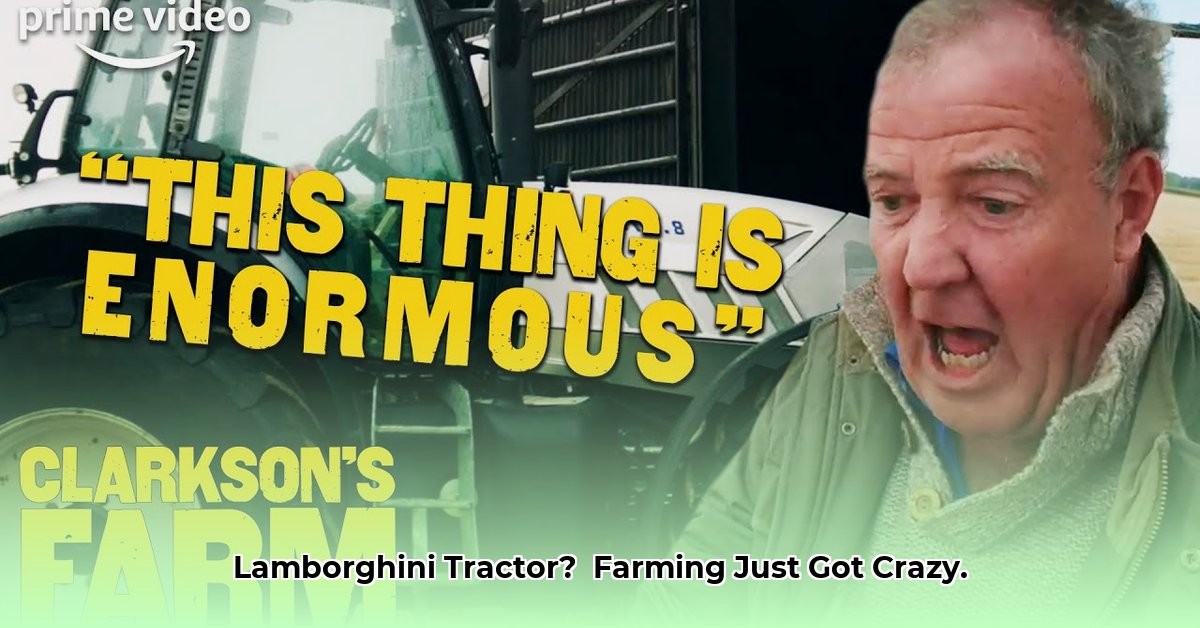
A Tractor That Demands Attention (and a Bigger Barn)
Jeremy Clarkson, famed for his high-octane adventures, traded speeding Ferraris for the decidedly less glamorous (but arguably more challenging) world of farming. And what better way to till the soil than with a Lamborghini tractor? His choice of a high-end Lamborghini Trattori R8 270 DCR—not exactly your grandpappy's tractor—has sparked a debate: is it a genius move or a ridiculously expensive mistake? This isn't just a farming story; it's a case study in high-end agricultural technology, its practicality, and the financial considerations for both large and small-scale farming operations. This deep dive will analyze Clarkson’s experience, comparing it to conventional farming practices, and exploring the broader implications for the future of agriculture. For a comparison, check out this Kubota tractor information. Is it practical for a small farm? That's the big question driving this analysis.
Technical Specifications and Features: The Lamborghini's Power
The Lamborghini Trattori R8 270 DCR is no ordinary tractor. Its sheer size—weighing between 9,430 kg and 10,435 kg, with dimensions of 5,268mm x 2,750mm x 3,270mm—commands attention. Think of a small car, but far heavier and built for serious agricultural work. It is a substantial investment and requires significantly more space than typical farming machinery. Its power, however, is undeniable. (Specific engine horsepower and torque figures would ideally be included here, sourced from Lamborghini Trattori specifications). The advanced technology incorporated into this tractor includes sophisticated control systems and features designed to maximize efficiency and minimize operator effort. But is this technology readily usable by farmers without extensive training?
Clarkson's Experience: Taming the Italian Stallion
Clarkson's documented experiences – from his TV show and writings – offer invaluable insights. He described operating the Lamborghini as akin to "piloting a spaceship instead of driving a pickup truck," highlighting the overwhelming number of controls compared to a conventional tractor. The sheer size and power, while impressive, presented challenges navigating the confines of his farm, creating moments that felt like "driving a tank through a maze." While the tractor's power proved beneficial for certain tasks, its size presented significant obstacles in smaller, tighter spaces, highlighting a key aspect in the cost-benefit analysis: suitability for the specific farm environment.
Lamborghini vs. The Competition: A Pricey Proposition?
The Lamborghini's £40,000 price tag dwarfs the £15,000-£30,000 cost of standard tractors. Though it offers superior power and technology, will these advantages outweigh the significantly higher upfront investment and ongoing maintenance costs? This necessitates a thorough cost-benefit analysis considering both short-term and long-term expenses including fuel efficiency and repair expenses. (A detailed comparative table, perhaps including data on fuel consumption per acre worked, would further enhance this section).
| Feature | Lamborghini R8 270 DCR | Conventional Tractor |
|---|---|---|
| Purchase Price | £40,000 | £15,000 - £30,000 |
| Engine Power | Significantly Higher | Significantly Lower |
| Ease of Use | More Challenging | Easier |
| Maintenance Costs | Potentially Higher | Potentially Lower |
| Long-Term ROI | Uncertain | Generally Positive |
Beyond Clarkson's Farm: The Future of Farming Technology
Clarkson's experience, however entertaining, touches on a larger discussion about the future of farming. The adoption of high-end technology, while offering potential improvements in efficiency and productivity, presents significant hurdles. The high cost of both purchase and subsequent maintenance limits access mainly to large-scale farms. Moreover, the complexity of operating these advanced machines also requires significant operator training and expertise, raising concerns about labor costs and skill shortages.
Conclusion: Luxury or Necessity?
Clarkson's Lamborghini tractor represents a fascinating case study in the intersection of high-end technology and agricultural practice. While its power and advanced features are undeniable, the extremely high initial investment and maintenance cost, coupled with the demand for specialized skills, lead to concerns for smaller farms. It's a high-risk/high-reward proposition, reinforcing that the suitability of such high-end machinery depends heavily on the specific context of individual farms and their operational needs. There is a need for further data collection and analysis to effectively determine the long-term viability and ROI for farms of various sizes.